THE INDIAN STANDARD ENGLISH
VerifiedAdded on 2022/08/28
|8
|1940
|34
AI Summary
Contribute Materials
Your contribution can guide someone’s learning journey. Share your
documents today.
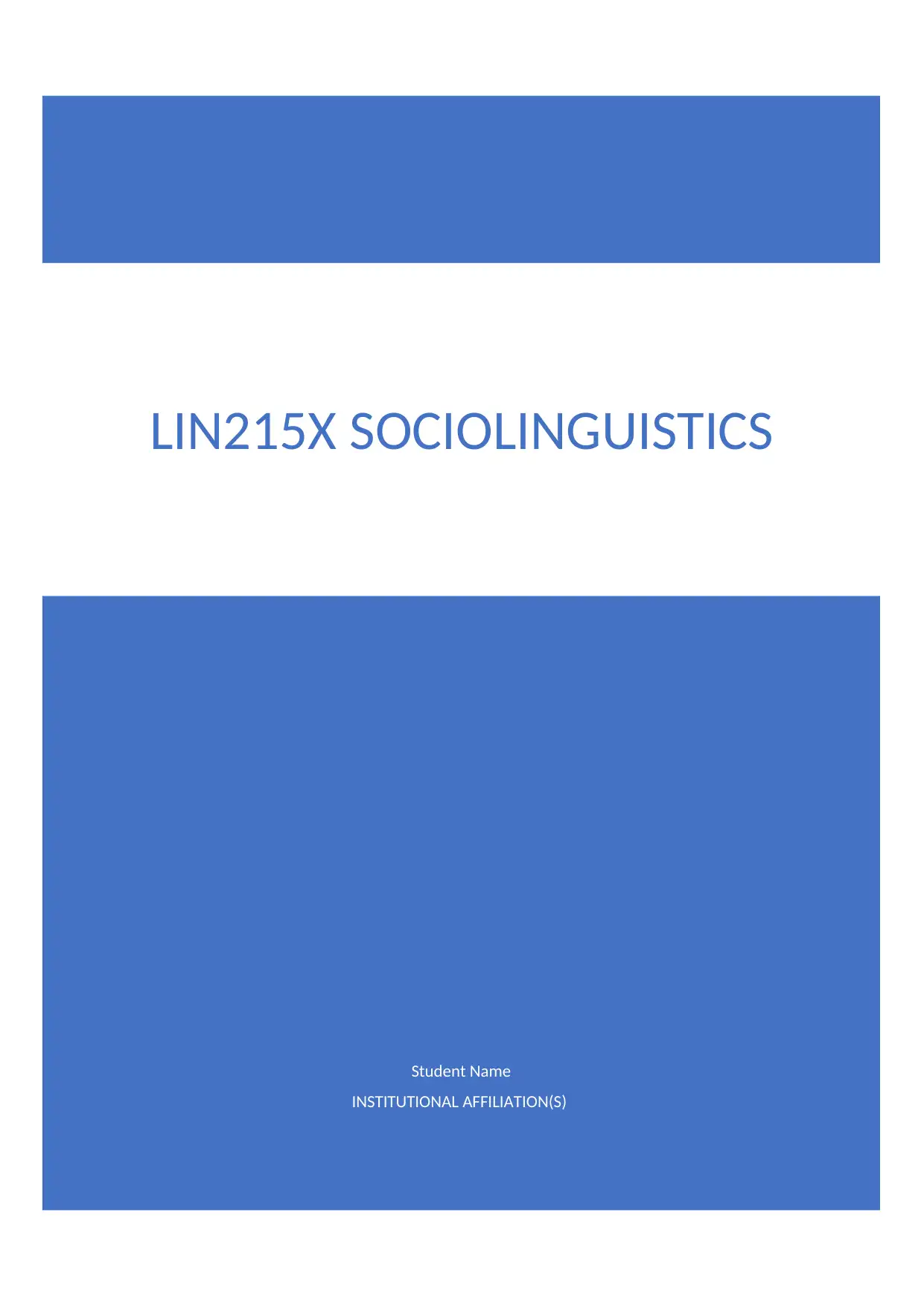
Student Name
INSTITUTIONAL AFFILIATION(S)
LIN215X SOCIOLINGUISTICS
INSTITUTIONAL AFFILIATION(S)
LIN215X SOCIOLINGUISTICS
Secure Best Marks with AI Grader
Need help grading? Try our AI Grader for instant feedback on your assignments.
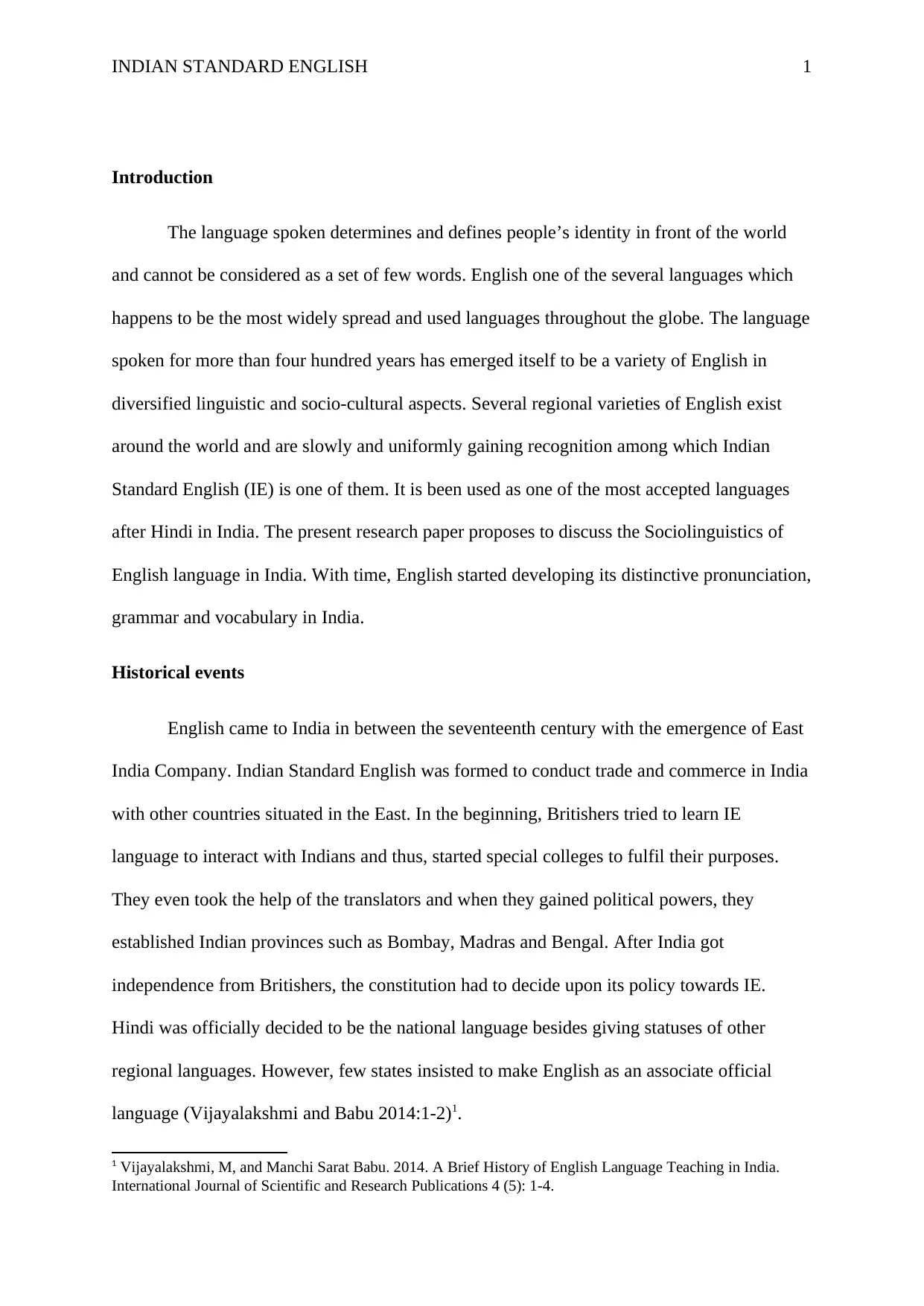
INDIAN STANDARD ENGLISH 1
Introduction
The language spoken determines and defines people’s identity in front of the world
and cannot be considered as a set of few words. English one of the several languages which
happens to be the most widely spread and used languages throughout the globe. The language
spoken for more than four hundred years has emerged itself to be a variety of English in
diversified linguistic and socio-cultural aspects. Several regional varieties of English exist
around the world and are slowly and uniformly gaining recognition among which Indian
Standard English (IE) is one of them. It is been used as one of the most accepted languages
after Hindi in India. The present research paper proposes to discuss the Sociolinguistics of
English language in India. With time, English started developing its distinctive pronunciation,
grammar and vocabulary in India.
Historical events
English came to India in between the seventeenth century with the emergence of East
India Company. Indian Standard English was formed to conduct trade and commerce in India
with other countries situated in the East. In the beginning, Britishers tried to learn IE
language to interact with Indians and thus, started special colleges to fulfil their purposes.
They even took the help of the translators and when they gained political powers, they
established Indian provinces such as Bombay, Madras and Bengal. After India got
independence from Britishers, the constitution had to decide upon its policy towards IE.
Hindi was officially decided to be the national language besides giving statuses of other
regional languages. However, few states insisted to make English as an associate official
language (Vijayalakshmi and Babu 2014:1-2)1.
1 Vijayalakshmi, M, and Manchi Sarat Babu. 2014. A Brief History of English Language Teaching in India.
International Journal of Scientific and Research Publications 4 (5): 1-4.
Introduction
The language spoken determines and defines people’s identity in front of the world
and cannot be considered as a set of few words. English one of the several languages which
happens to be the most widely spread and used languages throughout the globe. The language
spoken for more than four hundred years has emerged itself to be a variety of English in
diversified linguistic and socio-cultural aspects. Several regional varieties of English exist
around the world and are slowly and uniformly gaining recognition among which Indian
Standard English (IE) is one of them. It is been used as one of the most accepted languages
after Hindi in India. The present research paper proposes to discuss the Sociolinguistics of
English language in India. With time, English started developing its distinctive pronunciation,
grammar and vocabulary in India.
Historical events
English came to India in between the seventeenth century with the emergence of East
India Company. Indian Standard English was formed to conduct trade and commerce in India
with other countries situated in the East. In the beginning, Britishers tried to learn IE
language to interact with Indians and thus, started special colleges to fulfil their purposes.
They even took the help of the translators and when they gained political powers, they
established Indian provinces such as Bombay, Madras and Bengal. After India got
independence from Britishers, the constitution had to decide upon its policy towards IE.
Hindi was officially decided to be the national language besides giving statuses of other
regional languages. However, few states insisted to make English as an associate official
language (Vijayalakshmi and Babu 2014:1-2)1.
1 Vijayalakshmi, M, and Manchi Sarat Babu. 2014. A Brief History of English Language Teaching in India.
International Journal of Scientific and Research Publications 4 (5): 1-4.
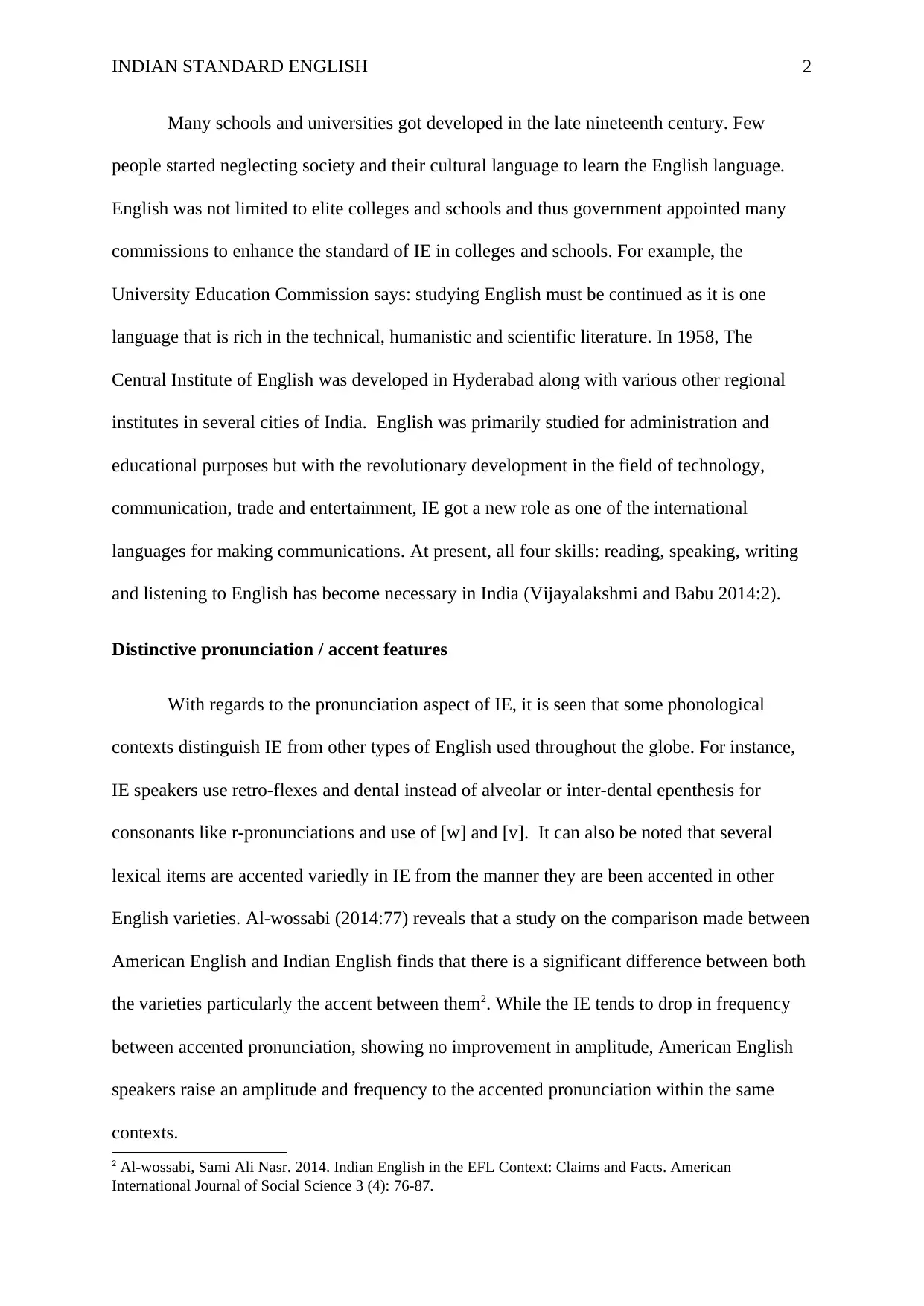
INDIAN STANDARD ENGLISH 2
Many schools and universities got developed in the late nineteenth century. Few
people started neglecting society and their cultural language to learn the English language.
English was not limited to elite colleges and schools and thus government appointed many
commissions to enhance the standard of IE in colleges and schools. For example, the
University Education Commission says: studying English must be continued as it is one
language that is rich in the technical, humanistic and scientific literature. In 1958, The
Central Institute of English was developed in Hyderabad along with various other regional
institutes in several cities of India. English was primarily studied for administration and
educational purposes but with the revolutionary development in the field of technology,
communication, trade and entertainment, IE got a new role as one of the international
languages for making communications. At present, all four skills: reading, speaking, writing
and listening to English has become necessary in India (Vijayalakshmi and Babu 2014:2).
Distinctive pronunciation / accent features
With regards to the pronunciation aspect of IE, it is seen that some phonological
contexts distinguish IE from other types of English used throughout the globe. For instance,
IE speakers use retro-flexes and dental instead of alveolar or inter-dental epenthesis for
consonants like r-pronunciations and use of [w] and [v]. It can also be noted that several
lexical items are accented variedly in IE from the manner they are been accented in other
English varieties. Al-wossabi (2014:77) reveals that a study on the comparison made between
American English and Indian English finds that there is a significant difference between both
the varieties particularly the accent between them2. While the IE tends to drop in frequency
between accented pronunciation, showing no improvement in amplitude, American English
speakers raise an amplitude and frequency to the accented pronunciation within the same
contexts.
2 Al-wossabi, Sami Ali Nasr. 2014. Indian English in the EFL Context: Claims and Facts. American
International Journal of Social Science 3 (4): 76-87.
Many schools and universities got developed in the late nineteenth century. Few
people started neglecting society and their cultural language to learn the English language.
English was not limited to elite colleges and schools and thus government appointed many
commissions to enhance the standard of IE in colleges and schools. For example, the
University Education Commission says: studying English must be continued as it is one
language that is rich in the technical, humanistic and scientific literature. In 1958, The
Central Institute of English was developed in Hyderabad along with various other regional
institutes in several cities of India. English was primarily studied for administration and
educational purposes but with the revolutionary development in the field of technology,
communication, trade and entertainment, IE got a new role as one of the international
languages for making communications. At present, all four skills: reading, speaking, writing
and listening to English has become necessary in India (Vijayalakshmi and Babu 2014:2).
Distinctive pronunciation / accent features
With regards to the pronunciation aspect of IE, it is seen that some phonological
contexts distinguish IE from other types of English used throughout the globe. For instance,
IE speakers use retro-flexes and dental instead of alveolar or inter-dental epenthesis for
consonants like r-pronunciations and use of [w] and [v]. It can also be noted that several
lexical items are accented variedly in IE from the manner they are been accented in other
English varieties. Al-wossabi (2014:77) reveals that a study on the comparison made between
American English and Indian English finds that there is a significant difference between both
the varieties particularly the accent between them2. While the IE tends to drop in frequency
between accented pronunciation, showing no improvement in amplitude, American English
speakers raise an amplitude and frequency to the accented pronunciation within the same
contexts.
2 Al-wossabi, Sami Ali Nasr. 2014. Indian English in the EFL Context: Claims and Facts. American
International Journal of Social Science 3 (4): 76-87.
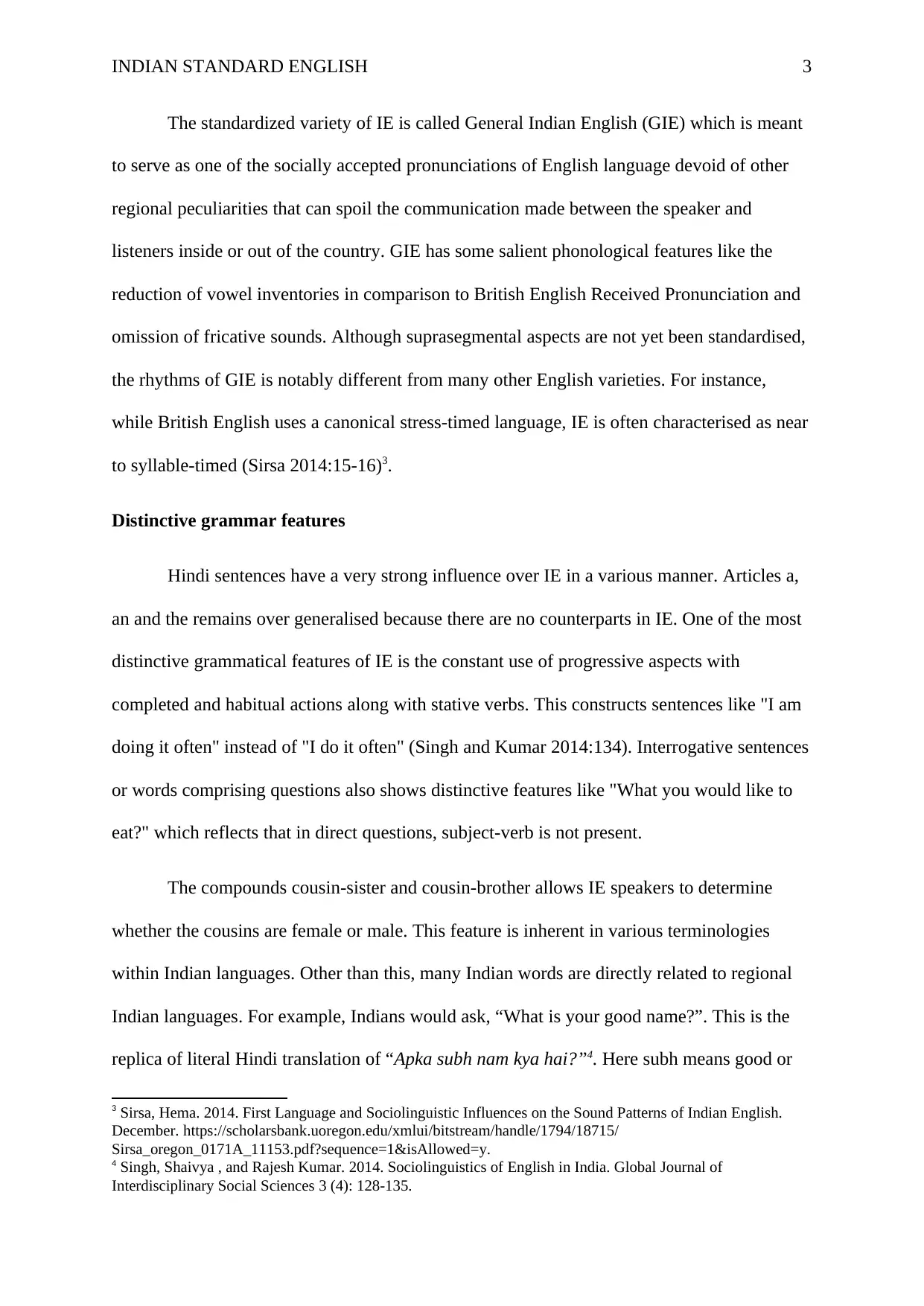
INDIAN STANDARD ENGLISH 3
The standardized variety of IE is called General Indian English (GIE) which is meant
to serve as one of the socially accepted pronunciations of English language devoid of other
regional peculiarities that can spoil the communication made between the speaker and
listeners inside or out of the country. GIE has some salient phonological features like the
reduction of vowel inventories in comparison to British English Received Pronunciation and
omission of fricative sounds. Although suprasegmental aspects are not yet been standardised,
the rhythms of GIE is notably different from many other English varieties. For instance,
while British English uses a canonical stress-timed language, IE is often characterised as near
to syllable-timed (Sirsa 2014:15-16)3.
Distinctive grammar features
Hindi sentences have a very strong influence over IE in a various manner. Articles a,
an and the remains over generalised because there are no counterparts in IE. One of the most
distinctive grammatical features of IE is the constant use of progressive aspects with
completed and habitual actions along with stative verbs. This constructs sentences like "I am
doing it often" instead of "I do it often" (Singh and Kumar 2014:134). Interrogative sentences
or words comprising questions also shows distinctive features like "What you would like to
eat?" which reflects that in direct questions, subject-verb is not present.
The compounds cousin-sister and cousin-brother allows IE speakers to determine
whether the cousins are female or male. This feature is inherent in various terminologies
within Indian languages. Other than this, many Indian words are directly related to regional
Indian languages. For example, Indians would ask, “What is your good name?”. This is the
replica of literal Hindi translation of “Apka subh nam kya hai?”4. Here subh means good or
3 Sirsa, Hema. 2014. First Language and Sociolinguistic Influences on the Sound Patterns of Indian English.
December. https://scholarsbank.uoregon.edu/xmlui/bitstream/handle/1794/18715/
Sirsa_oregon_0171A_11153.pdf?sequence=1&isAllowed=y.
4 Singh, Shaivya , and Rajesh Kumar. 2014. Sociolinguistics of English in India. Global Journal of
Interdisciplinary Social Sciences 3 (4): 128-135.
The standardized variety of IE is called General Indian English (GIE) which is meant
to serve as one of the socially accepted pronunciations of English language devoid of other
regional peculiarities that can spoil the communication made between the speaker and
listeners inside or out of the country. GIE has some salient phonological features like the
reduction of vowel inventories in comparison to British English Received Pronunciation and
omission of fricative sounds. Although suprasegmental aspects are not yet been standardised,
the rhythms of GIE is notably different from many other English varieties. For instance,
while British English uses a canonical stress-timed language, IE is often characterised as near
to syllable-timed (Sirsa 2014:15-16)3.
Distinctive grammar features
Hindi sentences have a very strong influence over IE in a various manner. Articles a,
an and the remains over generalised because there are no counterparts in IE. One of the most
distinctive grammatical features of IE is the constant use of progressive aspects with
completed and habitual actions along with stative verbs. This constructs sentences like "I am
doing it often" instead of "I do it often" (Singh and Kumar 2014:134). Interrogative sentences
or words comprising questions also shows distinctive features like "What you would like to
eat?" which reflects that in direct questions, subject-verb is not present.
The compounds cousin-sister and cousin-brother allows IE speakers to determine
whether the cousins are female or male. This feature is inherent in various terminologies
within Indian languages. Other than this, many Indian words are directly related to regional
Indian languages. For example, Indians would ask, “What is your good name?”. This is the
replica of literal Hindi translation of “Apka subh nam kya hai?”4. Here subh means good or
3 Sirsa, Hema. 2014. First Language and Sociolinguistic Influences on the Sound Patterns of Indian English.
December. https://scholarsbank.uoregon.edu/xmlui/bitstream/handle/1794/18715/
Sirsa_oregon_0171A_11153.pdf?sequence=1&isAllowed=y.
4 Singh, Shaivya , and Rajesh Kumar. 2014. Sociolinguistics of English in India. Global Journal of
Interdisciplinary Social Sciences 3 (4): 128-135.
Secure Best Marks with AI Grader
Need help grading? Try our AI Grader for instant feedback on your assignments.
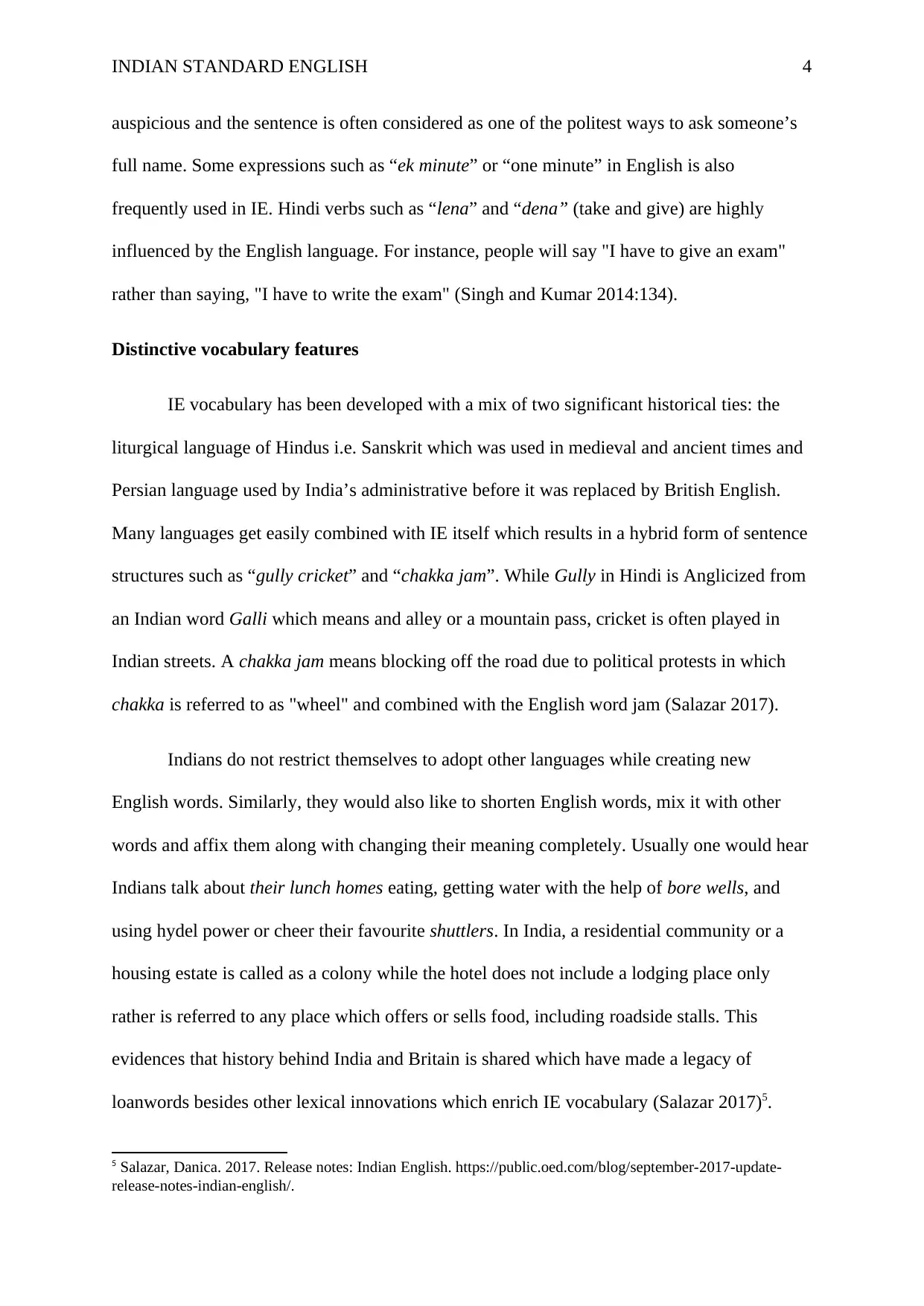
INDIAN STANDARD ENGLISH 4
auspicious and the sentence is often considered as one of the politest ways to ask someone’s
full name. Some expressions such as “ek minute” or “one minute” in English is also
frequently used in IE. Hindi verbs such as “lena” and “dena” (take and give) are highly
influenced by the English language. For instance, people will say "I have to give an exam"
rather than saying, "I have to write the exam" (Singh and Kumar 2014:134).
Distinctive vocabulary features
IE vocabulary has been developed with a mix of two significant historical ties: the
liturgical language of Hindus i.e. Sanskrit which was used in medieval and ancient times and
Persian language used by India’s administrative before it was replaced by British English.
Many languages get easily combined with IE itself which results in a hybrid form of sentence
structures such as “gully cricket” and “chakka jam”. While Gully in Hindi is Anglicized from
an Indian word Galli which means and alley or a mountain pass, cricket is often played in
Indian streets. A chakka jam means blocking off the road due to political protests in which
chakka is referred to as "wheel" and combined with the English word jam (Salazar 2017).
Indians do not restrict themselves to adopt other languages while creating new
English words. Similarly, they would also like to shorten English words, mix it with other
words and affix them along with changing their meaning completely. Usually one would hear
Indians talk about their lunch homes eating, getting water with the help of bore wells, and
using hydel power or cheer their favourite shuttlers. In India, a residential community or a
housing estate is called as a colony while the hotel does not include a lodging place only
rather is referred to any place which offers or sells food, including roadside stalls. This
evidences that history behind India and Britain is shared which have made a legacy of
loanwords besides other lexical innovations which enrich IE vocabulary (Salazar 2017)5.
5 Salazar, Danica. 2017. Release notes: Indian English. https://public.oed.com/blog/september-2017-update-
release-notes-indian-english/.
auspicious and the sentence is often considered as one of the politest ways to ask someone’s
full name. Some expressions such as “ek minute” or “one minute” in English is also
frequently used in IE. Hindi verbs such as “lena” and “dena” (take and give) are highly
influenced by the English language. For instance, people will say "I have to give an exam"
rather than saying, "I have to write the exam" (Singh and Kumar 2014:134).
Distinctive vocabulary features
IE vocabulary has been developed with a mix of two significant historical ties: the
liturgical language of Hindus i.e. Sanskrit which was used in medieval and ancient times and
Persian language used by India’s administrative before it was replaced by British English.
Many languages get easily combined with IE itself which results in a hybrid form of sentence
structures such as “gully cricket” and “chakka jam”. While Gully in Hindi is Anglicized from
an Indian word Galli which means and alley or a mountain pass, cricket is often played in
Indian streets. A chakka jam means blocking off the road due to political protests in which
chakka is referred to as "wheel" and combined with the English word jam (Salazar 2017).
Indians do not restrict themselves to adopt other languages while creating new
English words. Similarly, they would also like to shorten English words, mix it with other
words and affix them along with changing their meaning completely. Usually one would hear
Indians talk about their lunch homes eating, getting water with the help of bore wells, and
using hydel power or cheer their favourite shuttlers. In India, a residential community or a
housing estate is called as a colony while the hotel does not include a lodging place only
rather is referred to any place which offers or sells food, including roadside stalls. This
evidences that history behind India and Britain is shared which have made a legacy of
loanwords besides other lexical innovations which enrich IE vocabulary (Salazar 2017)5.
5 Salazar, Danica. 2017. Release notes: Indian English. https://public.oed.com/blog/september-2017-update-
release-notes-indian-english/.
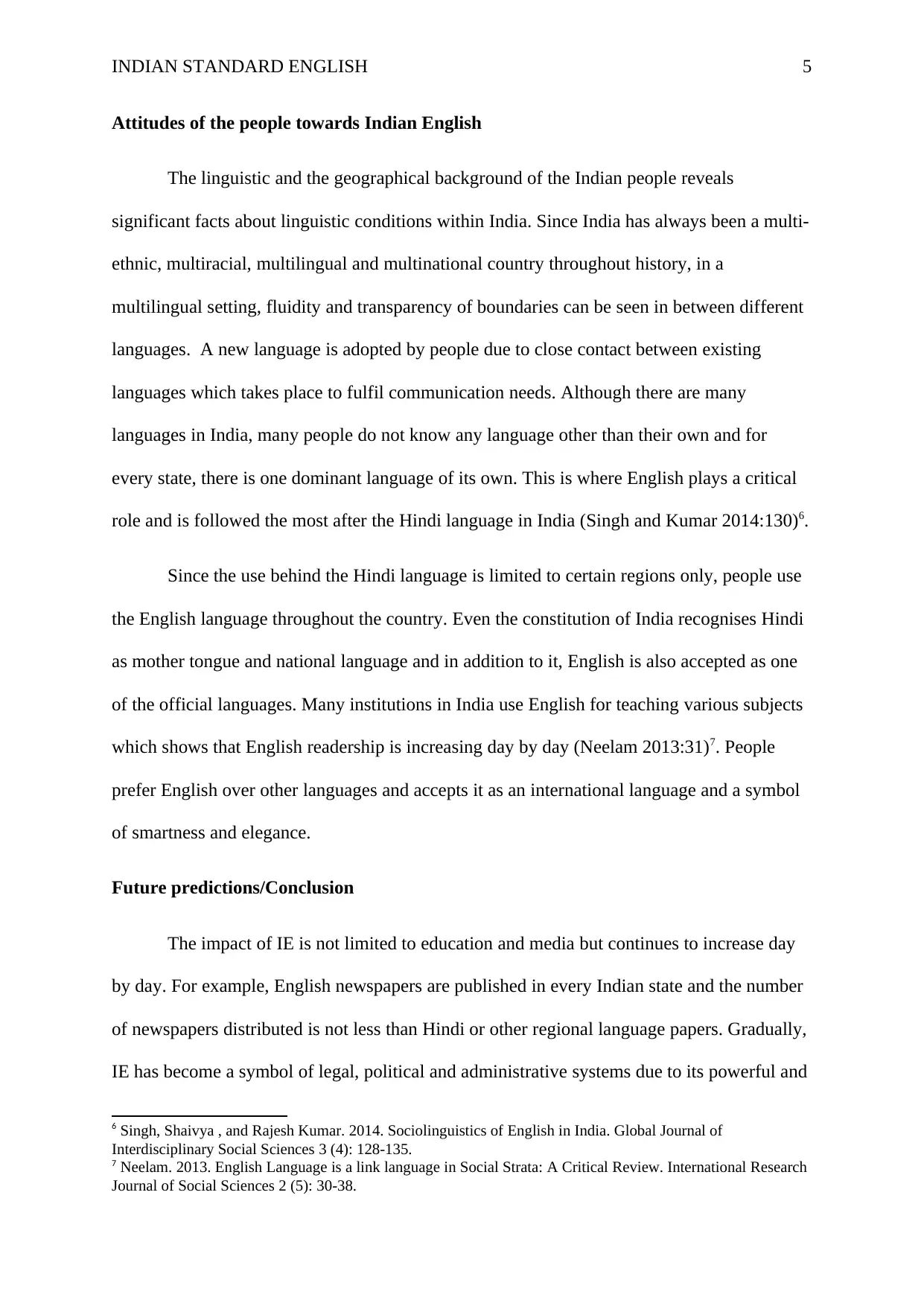
INDIAN STANDARD ENGLISH 5
Attitudes of the people towards Indian English
The linguistic and the geographical background of the Indian people reveals
significant facts about linguistic conditions within India. Since India has always been a multi-
ethnic, multiracial, multilingual and multinational country throughout history, in a
multilingual setting, fluidity and transparency of boundaries can be seen in between different
languages. A new language is adopted by people due to close contact between existing
languages which takes place to fulfil communication needs. Although there are many
languages in India, many people do not know any language other than their own and for
every state, there is one dominant language of its own. This is where English plays a critical
role and is followed the most after the Hindi language in India (Singh and Kumar 2014:130)6.
Since the use behind the Hindi language is limited to certain regions only, people use
the English language throughout the country. Even the constitution of India recognises Hindi
as mother tongue and national language and in addition to it, English is also accepted as one
of the official languages. Many institutions in India use English for teaching various subjects
which shows that English readership is increasing day by day (Neelam 2013:31)7. People
prefer English over other languages and accepts it as an international language and a symbol
of smartness and elegance.
Future predictions/Conclusion
The impact of IE is not limited to education and media but continues to increase day
by day. For example, English newspapers are published in every Indian state and the number
of newspapers distributed is not less than Hindi or other regional language papers. Gradually,
IE has become a symbol of legal, political and administrative systems due to its powerful and
6 Singh, Shaivya , and Rajesh Kumar. 2014. Sociolinguistics of English in India. Global Journal of
Interdisciplinary Social Sciences 3 (4): 128-135.
7 Neelam. 2013. English Language is a link language in Social Strata: A Critical Review. International Research
Journal of Social Sciences 2 (5): 30-38.
Attitudes of the people towards Indian English
The linguistic and the geographical background of the Indian people reveals
significant facts about linguistic conditions within India. Since India has always been a multi-
ethnic, multiracial, multilingual and multinational country throughout history, in a
multilingual setting, fluidity and transparency of boundaries can be seen in between different
languages. A new language is adopted by people due to close contact between existing
languages which takes place to fulfil communication needs. Although there are many
languages in India, many people do not know any language other than their own and for
every state, there is one dominant language of its own. This is where English plays a critical
role and is followed the most after the Hindi language in India (Singh and Kumar 2014:130)6.
Since the use behind the Hindi language is limited to certain regions only, people use
the English language throughout the country. Even the constitution of India recognises Hindi
as mother tongue and national language and in addition to it, English is also accepted as one
of the official languages. Many institutions in India use English for teaching various subjects
which shows that English readership is increasing day by day (Neelam 2013:31)7. People
prefer English over other languages and accepts it as an international language and a symbol
of smartness and elegance.
Future predictions/Conclusion
The impact of IE is not limited to education and media but continues to increase day
by day. For example, English newspapers are published in every Indian state and the number
of newspapers distributed is not less than Hindi or other regional language papers. Gradually,
IE has become a symbol of legal, political and administrative systems due to its powerful and
6 Singh, Shaivya , and Rajesh Kumar. 2014. Sociolinguistics of English in India. Global Journal of
Interdisciplinary Social Sciences 3 (4): 128-135.
7 Neelam. 2013. English Language is a link language in Social Strata: A Critical Review. International Research
Journal of Social Sciences 2 (5): 30-38.
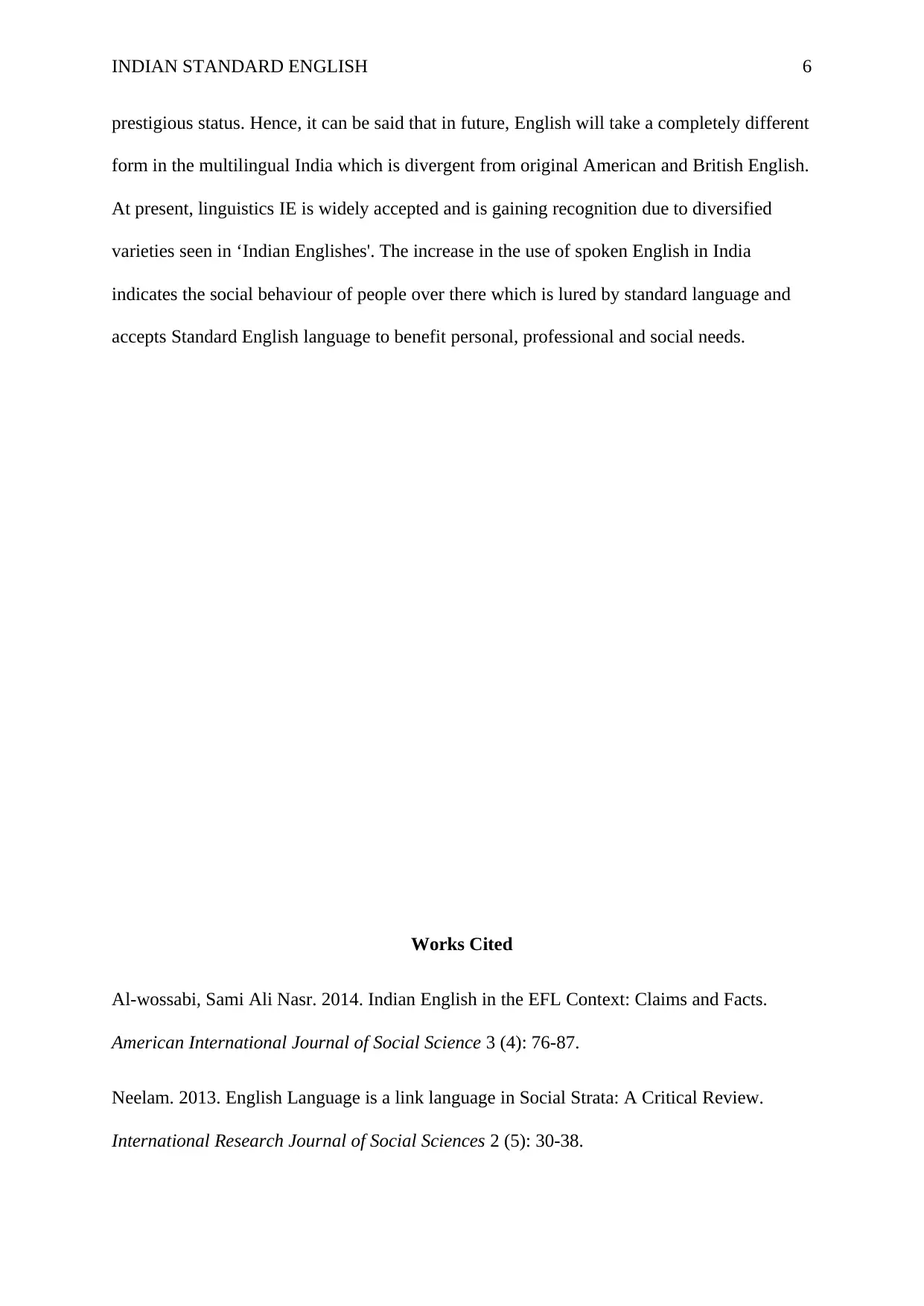
INDIAN STANDARD ENGLISH 6
prestigious status. Hence, it can be said that in future, English will take a completely different
form in the multilingual India which is divergent from original American and British English.
At present, linguistics IE is widely accepted and is gaining recognition due to diversified
varieties seen in ‘Indian Englishes'. The increase in the use of spoken English in India
indicates the social behaviour of people over there which is lured by standard language and
accepts Standard English language to benefit personal, professional and social needs.
Works Cited
Al-wossabi, Sami Ali Nasr. 2014. Indian English in the EFL Context: Claims and Facts.
American International Journal of Social Science 3 (4): 76-87.
Neelam. 2013. English Language is a link language in Social Strata: A Critical Review.
International Research Journal of Social Sciences 2 (5): 30-38.
prestigious status. Hence, it can be said that in future, English will take a completely different
form in the multilingual India which is divergent from original American and British English.
At present, linguistics IE is widely accepted and is gaining recognition due to diversified
varieties seen in ‘Indian Englishes'. The increase in the use of spoken English in India
indicates the social behaviour of people over there which is lured by standard language and
accepts Standard English language to benefit personal, professional and social needs.
Works Cited
Al-wossabi, Sami Ali Nasr. 2014. Indian English in the EFL Context: Claims and Facts.
American International Journal of Social Science 3 (4): 76-87.
Neelam. 2013. English Language is a link language in Social Strata: A Critical Review.
International Research Journal of Social Sciences 2 (5): 30-38.
Paraphrase This Document
Need a fresh take? Get an instant paraphrase of this document with our AI Paraphraser
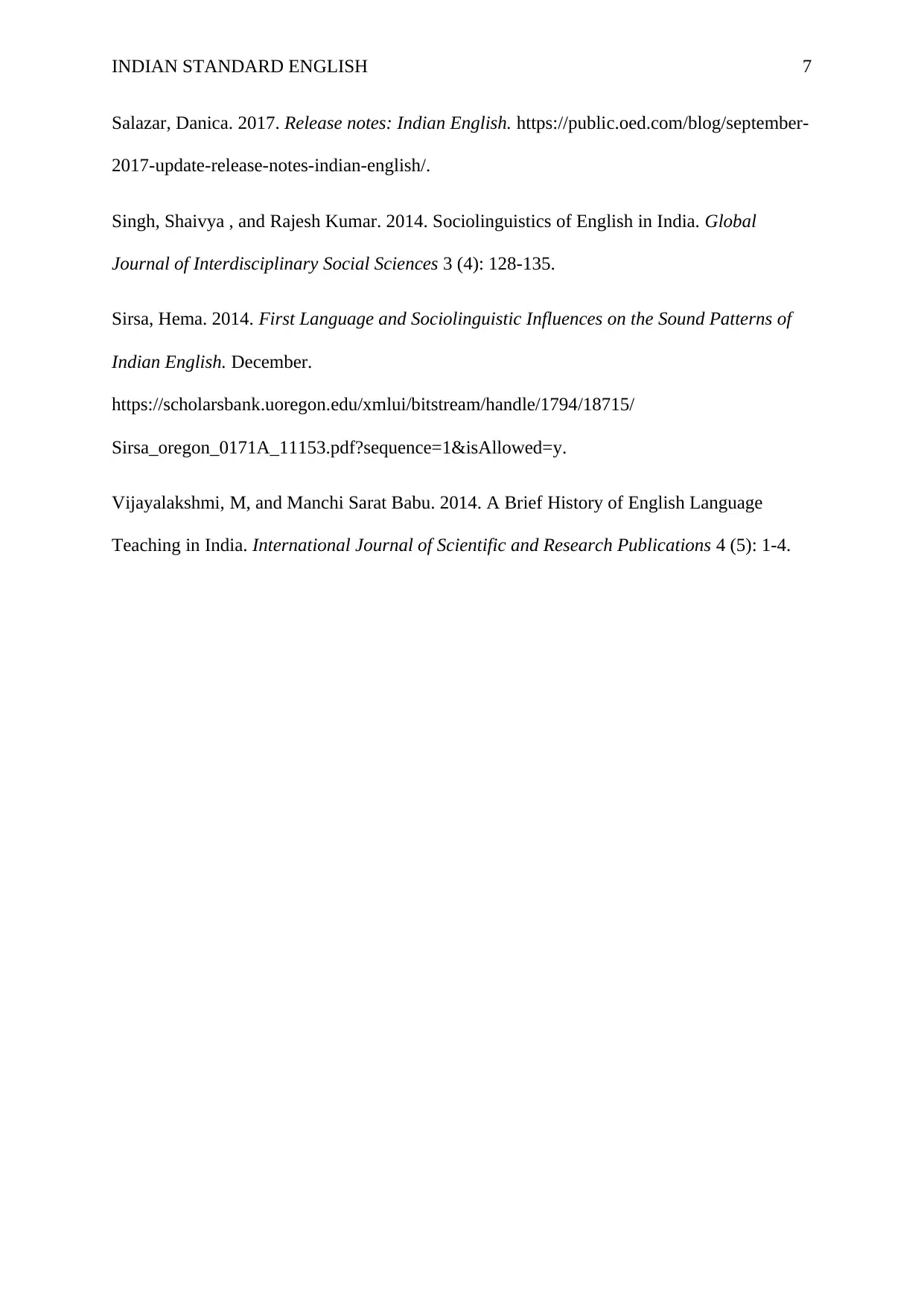
INDIAN STANDARD ENGLISH 7
Salazar, Danica. 2017. Release notes: Indian English. https://public.oed.com/blog/september-
2017-update-release-notes-indian-english/.
Singh, Shaivya , and Rajesh Kumar. 2014. Sociolinguistics of English in India. Global
Journal of Interdisciplinary Social Sciences 3 (4): 128-135.
Sirsa, Hema. 2014. First Language and Sociolinguistic Influences on the Sound Patterns of
Indian English. December.
https://scholarsbank.uoregon.edu/xmlui/bitstream/handle/1794/18715/
Sirsa_oregon_0171A_11153.pdf?sequence=1&isAllowed=y.
Vijayalakshmi, M, and Manchi Sarat Babu. 2014. A Brief History of English Language
Teaching in India. International Journal of Scientific and Research Publications 4 (5): 1-4.
Salazar, Danica. 2017. Release notes: Indian English. https://public.oed.com/blog/september-
2017-update-release-notes-indian-english/.
Singh, Shaivya , and Rajesh Kumar. 2014. Sociolinguistics of English in India. Global
Journal of Interdisciplinary Social Sciences 3 (4): 128-135.
Sirsa, Hema. 2014. First Language and Sociolinguistic Influences on the Sound Patterns of
Indian English. December.
https://scholarsbank.uoregon.edu/xmlui/bitstream/handle/1794/18715/
Sirsa_oregon_0171A_11153.pdf?sequence=1&isAllowed=y.
Vijayalakshmi, M, and Manchi Sarat Babu. 2014. A Brief History of English Language
Teaching in India. International Journal of Scientific and Research Publications 4 (5): 1-4.
1 out of 8
Your All-in-One AI-Powered Toolkit for Academic Success.
+13062052269
info@desklib.com
Available 24*7 on WhatsApp / Email
![[object Object]](/_next/static/media/star-bottom.7253800d.svg)
Unlock your academic potential
© 2024 | Zucol Services PVT LTD | All rights reserved.